Exploring Nurses' and Care Workers' Experiences in Dementia Care
VerifiedAdded on 2023/06/14
|53
|23201
|164
Thesis and Dissertation
AI Summary
This dissertation investigates the experiences of nurses and care workers dealing with challenging behaviors exhibited by individuals with dementia. It begins with an introduction to dementia, its prevalence, and its impact on caregivers, followed by a comprehensive literature review examining the roles, challenges, and coping strategies employed by nurses and care workers. The methodology section outlines the research approach, including eligibility criteria, search strategy, study selection, quality appraisal, risk of bias assessment, and data extraction methods. The results section describes the included studies, risk of bias, and the effects of interventions. The discussion section summarizes the main findings, assesses the certainty of evidence, identifies potential biases, and compares the results with other studies. The dissertation concludes with implications for practice and recommendations for future research, emphasizing the importance of effective communication, relationship building, and tailored care plans to improve the quality of life for both patients and caregivers. Appendices include supporting documents such as ethical approval, missing data information, CASP tables, and a PRISMA chart.

Dissertation & Ph.D.
Thesis
Thesis
Paraphrase This Document
Need a fresh take? Get an instant paraphrase of this document with our AI Paraphraser
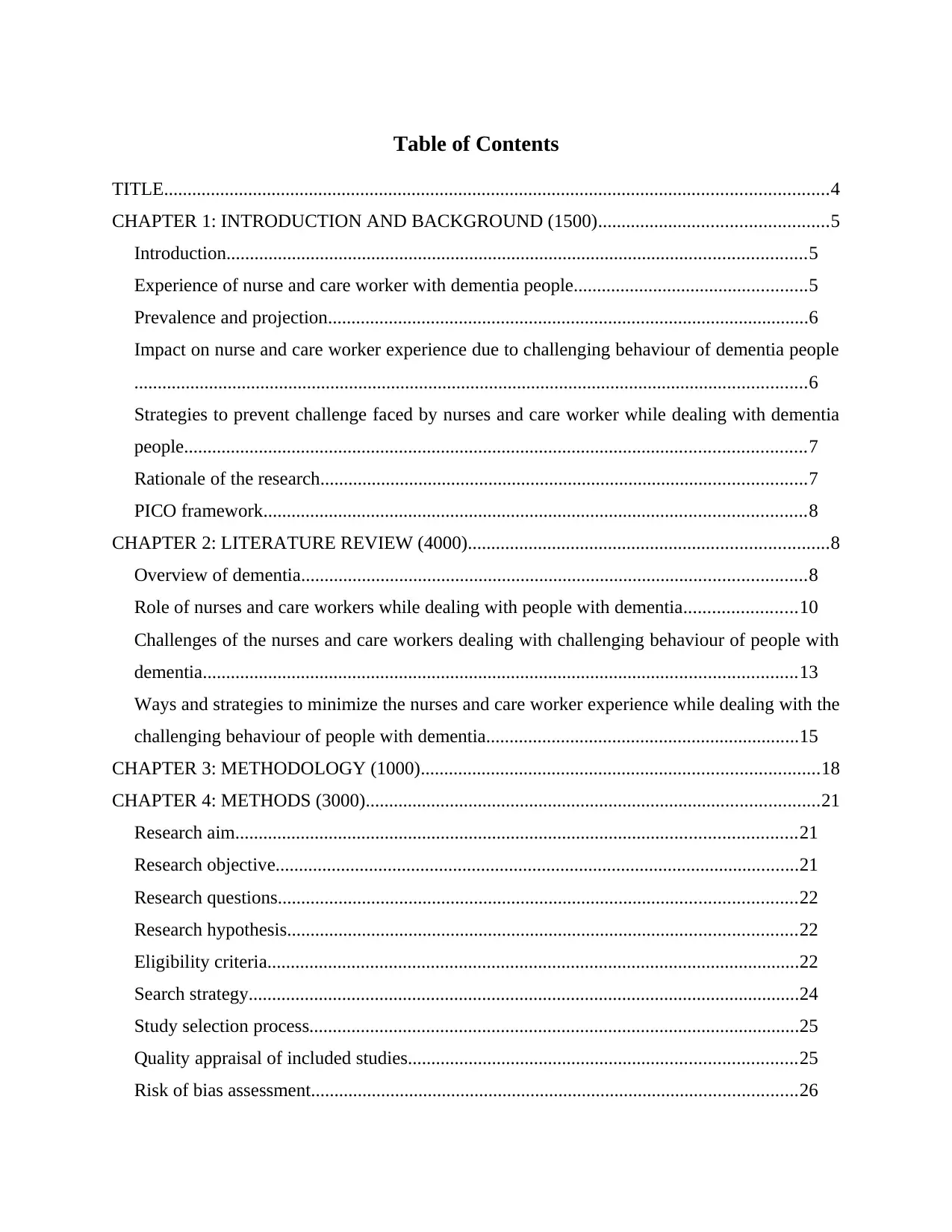
Table of Contents
TITLE..............................................................................................................................................4
CHAPTER 1: INTRODUCTION AND BACKGROUND (1500).................................................5
Introduction............................................................................................................................5
Experience of nurse and care worker with dementia people..................................................5
Prevalence and projection.......................................................................................................6
Impact on nurse and care worker experience due to challenging behaviour of dementia people
................................................................................................................................................6
Strategies to prevent challenge faced by nurses and care worker while dealing with dementia
people.....................................................................................................................................7
Rationale of the research........................................................................................................7
PICO framework....................................................................................................................8
CHAPTER 2: LITERATURE REVIEW (4000).............................................................................8
Overview of dementia............................................................................................................8
Role of nurses and care workers while dealing with people with dementia........................10
Challenges of the nurses and care workers dealing with challenging behaviour of people with
dementia...............................................................................................................................13
Ways and strategies to minimize the nurses and care worker experience while dealing with the
challenging behaviour of people with dementia...................................................................15
CHAPTER 3: METHODOLOGY (1000).....................................................................................18
CHAPTER 4: METHODS (3000).................................................................................................21
Research aim........................................................................................................................21
Research objective................................................................................................................21
Research questions...............................................................................................................22
Research hypothesis.............................................................................................................22
Eligibility criteria..................................................................................................................22
Search strategy......................................................................................................................24
Study selection process.........................................................................................................25
Quality appraisal of included studies...................................................................................25
Risk of bias assessment........................................................................................................26
TITLE..............................................................................................................................................4
CHAPTER 1: INTRODUCTION AND BACKGROUND (1500).................................................5
Introduction............................................................................................................................5
Experience of nurse and care worker with dementia people..................................................5
Prevalence and projection.......................................................................................................6
Impact on nurse and care worker experience due to challenging behaviour of dementia people
................................................................................................................................................6
Strategies to prevent challenge faced by nurses and care worker while dealing with dementia
people.....................................................................................................................................7
Rationale of the research........................................................................................................7
PICO framework....................................................................................................................8
CHAPTER 2: LITERATURE REVIEW (4000).............................................................................8
Overview of dementia............................................................................................................8
Role of nurses and care workers while dealing with people with dementia........................10
Challenges of the nurses and care workers dealing with challenging behaviour of people with
dementia...............................................................................................................................13
Ways and strategies to minimize the nurses and care worker experience while dealing with the
challenging behaviour of people with dementia...................................................................15
CHAPTER 3: METHODOLOGY (1000).....................................................................................18
CHAPTER 4: METHODS (3000).................................................................................................21
Research aim........................................................................................................................21
Research objective................................................................................................................21
Research questions...............................................................................................................22
Research hypothesis.............................................................................................................22
Eligibility criteria..................................................................................................................22
Search strategy......................................................................................................................24
Study selection process.........................................................................................................25
Quality appraisal of included studies...................................................................................25
Risk of bias assessment........................................................................................................26
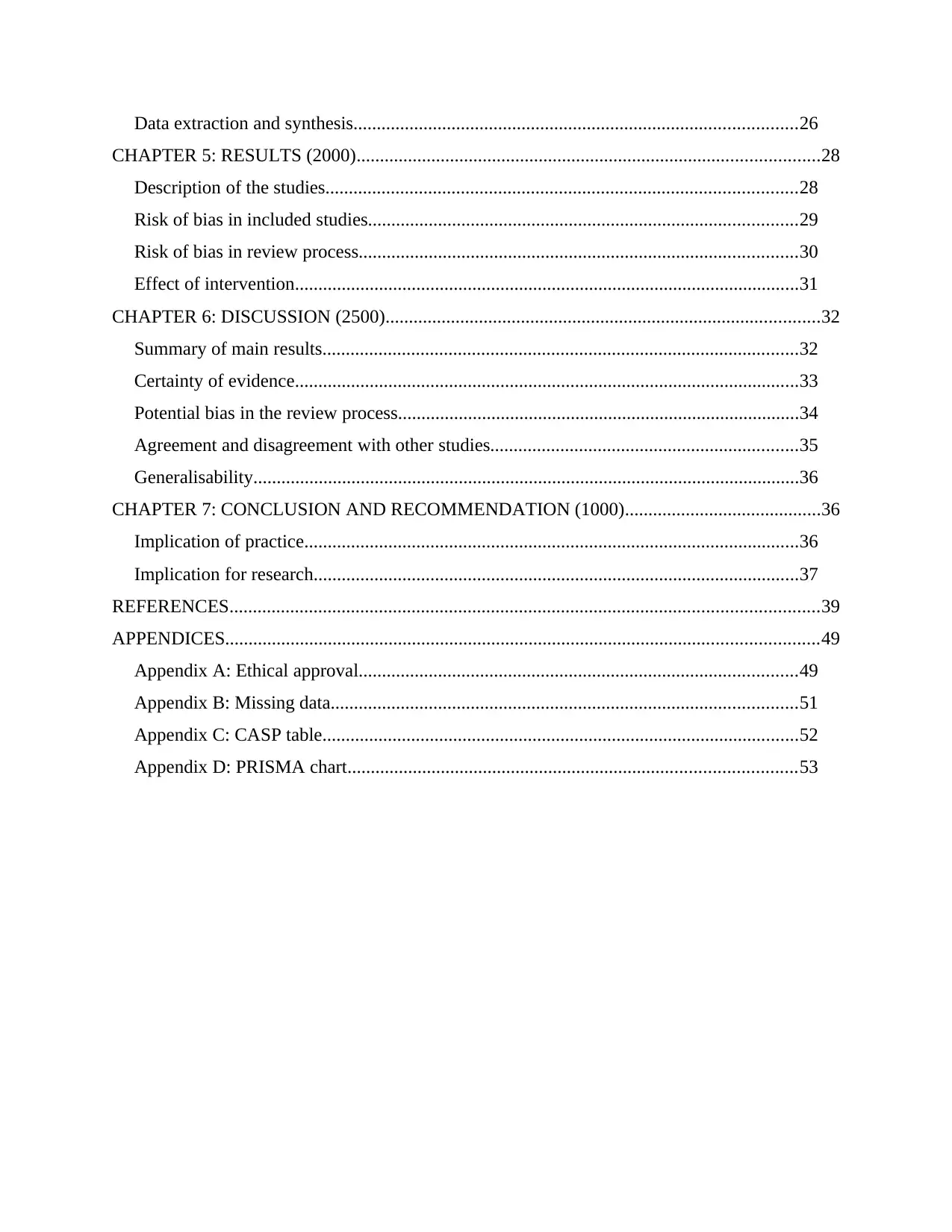
Data extraction and synthesis...............................................................................................26
CHAPTER 5: RESULTS (2000)...................................................................................................28
Description of the studies.....................................................................................................28
Risk of bias in included studies............................................................................................29
Risk of bias in review process..............................................................................................30
Effect of intervention............................................................................................................31
CHAPTER 6: DISCUSSION (2500).............................................................................................32
Summary of main results......................................................................................................32
Certainty of evidence............................................................................................................33
Potential bias in the review process......................................................................................34
Agreement and disagreement with other studies..................................................................35
Generalisability.....................................................................................................................36
CHAPTER 7: CONCLUSION AND RECOMMENDATION (1000)..........................................36
Implication of practice..........................................................................................................36
Implication for research........................................................................................................37
REFERENCES..............................................................................................................................39
APPENDICES...............................................................................................................................49
Appendix A: Ethical approval..............................................................................................49
Appendix B: Missing data....................................................................................................51
Appendix C: CASP table......................................................................................................52
Appendix D: PRISMA chart................................................................................................53
CHAPTER 5: RESULTS (2000)...................................................................................................28
Description of the studies.....................................................................................................28
Risk of bias in included studies............................................................................................29
Risk of bias in review process..............................................................................................30
Effect of intervention............................................................................................................31
CHAPTER 6: DISCUSSION (2500).............................................................................................32
Summary of main results......................................................................................................32
Certainty of evidence............................................................................................................33
Potential bias in the review process......................................................................................34
Agreement and disagreement with other studies..................................................................35
Generalisability.....................................................................................................................36
CHAPTER 7: CONCLUSION AND RECOMMENDATION (1000)..........................................36
Implication of practice..........................................................................................................36
Implication for research........................................................................................................37
REFERENCES..............................................................................................................................39
APPENDICES...............................................................................................................................49
Appendix A: Ethical approval..............................................................................................49
Appendix B: Missing data....................................................................................................51
Appendix C: CASP table......................................................................................................52
Appendix D: PRISMA chart................................................................................................53
⊘ This is a preview!⊘
Do you want full access?
Subscribe today to unlock all pages.

Trusted by 1+ million students worldwide

TITLE
"Nurses' and care workers' experience while dealing with challenging behaviour of people with
dementia."
"Nurses' and care workers' experience while dealing with challenging behaviour of people with
dementia."
Paraphrase This Document
Need a fresh take? Get an instant paraphrase of this document with our AI Paraphraser
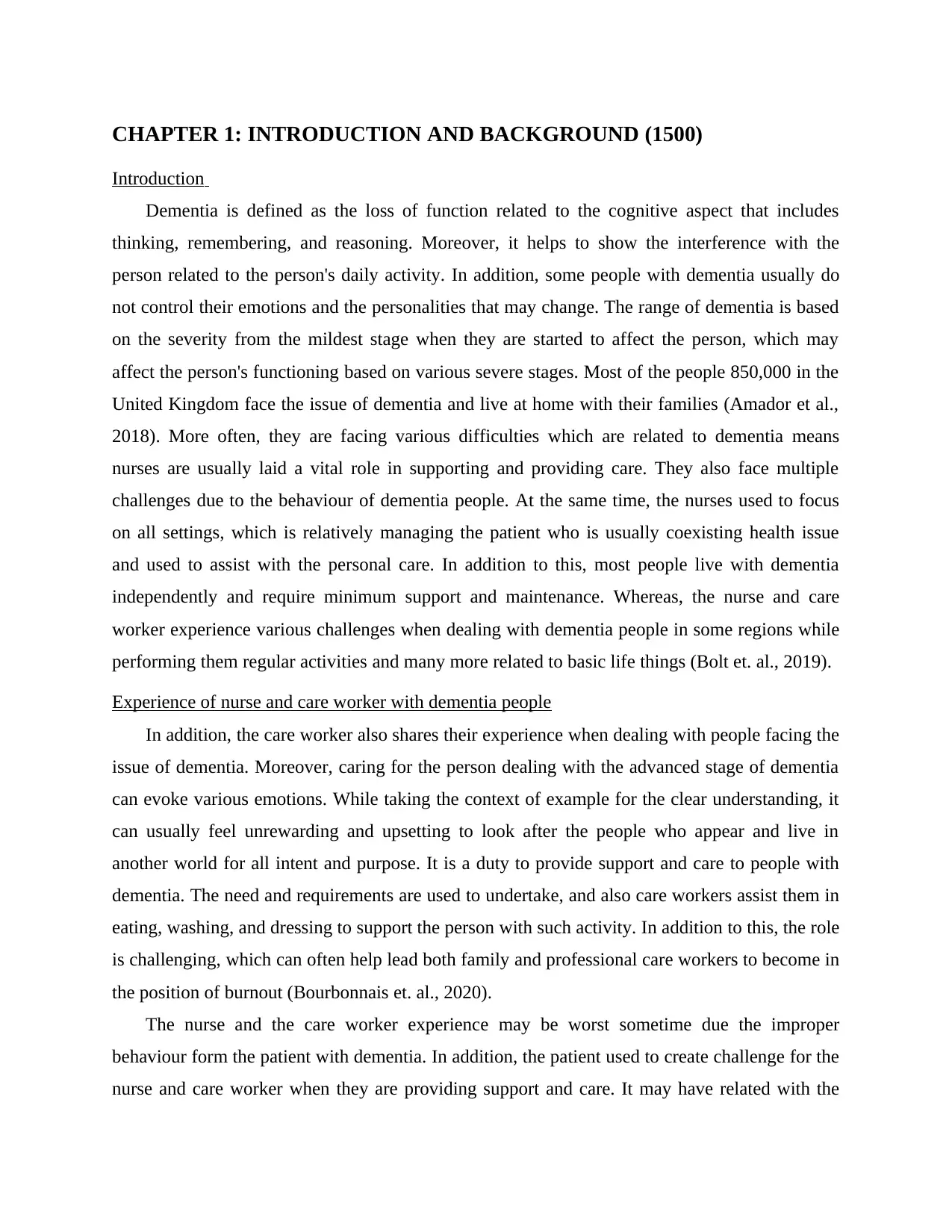
CHAPTER 1: INTRODUCTION AND BACKGROUND (1500)
Introduction
Dementia is defined as the loss of function related to the cognitive aspect that includes
thinking, remembering, and reasoning. Moreover, it helps to show the interference with the
person related to the person's daily activity. In addition, some people with dementia usually do
not control their emotions and the personalities that may change. The range of dementia is based
on the severity from the mildest stage when they are started to affect the person, which may
affect the person's functioning based on various severe stages. Most of the people 850,000 in the
United Kingdom face the issue of dementia and live at home with their families (Amador et al.,
2018). More often, they are facing various difficulties which are related to dementia means
nurses are usually laid a vital role in supporting and providing care. They also face multiple
challenges due to the behaviour of dementia people. At the same time, the nurses used to focus
on all settings, which is relatively managing the patient who is usually coexisting health issue
and used to assist with the personal care. In addition to this, most people live with dementia
independently and require minimum support and maintenance. Whereas, the nurse and care
worker experience various challenges when dealing with dementia people in some regions while
performing them regular activities and many more related to basic life things (Bolt et. al., 2019).
Experience of nurse and care worker with dementia people
In addition, the care worker also shares their experience when dealing with people facing the
issue of dementia. Moreover, caring for the person dealing with the advanced stage of dementia
can evoke various emotions. While taking the context of example for the clear understanding, it
can usually feel unrewarding and upsetting to look after the people who appear and live in
another world for all intent and purpose. It is a duty to provide support and care to people with
dementia. The need and requirements are used to undertake, and also care workers assist them in
eating, washing, and dressing to support the person with such activity. In addition to this, the role
is challenging, which can often help lead both family and professional care workers to become in
the position of burnout (Bourbonnais et. al., 2020).
The nurse and the care worker experience may be worst sometime due the improper
behaviour form the patient with dementia. In addition, the patient used to create challenge for the
nurse and care worker when they are providing support and care. It may have related with the
Introduction
Dementia is defined as the loss of function related to the cognitive aspect that includes
thinking, remembering, and reasoning. Moreover, it helps to show the interference with the
person related to the person's daily activity. In addition, some people with dementia usually do
not control their emotions and the personalities that may change. The range of dementia is based
on the severity from the mildest stage when they are started to affect the person, which may
affect the person's functioning based on various severe stages. Most of the people 850,000 in the
United Kingdom face the issue of dementia and live at home with their families (Amador et al.,
2018). More often, they are facing various difficulties which are related to dementia means
nurses are usually laid a vital role in supporting and providing care. They also face multiple
challenges due to the behaviour of dementia people. At the same time, the nurses used to focus
on all settings, which is relatively managing the patient who is usually coexisting health issue
and used to assist with the personal care. In addition to this, most people live with dementia
independently and require minimum support and maintenance. Whereas, the nurse and care
worker experience various challenges when dealing with dementia people in some regions while
performing them regular activities and many more related to basic life things (Bolt et. al., 2019).
Experience of nurse and care worker with dementia people
In addition, the care worker also shares their experience when dealing with people facing the
issue of dementia. Moreover, caring for the person dealing with the advanced stage of dementia
can evoke various emotions. While taking the context of example for the clear understanding, it
can usually feel unrewarding and upsetting to look after the people who appear and live in
another world for all intent and purpose. It is a duty to provide support and care to people with
dementia. The need and requirements are used to undertake, and also care workers assist them in
eating, washing, and dressing to support the person with such activity. In addition to this, the role
is challenging, which can often help lead both family and professional care workers to become in
the position of burnout (Bourbonnais et. al., 2020).
The nurse and the care worker experience may be worst sometime due the improper
behaviour form the patient with dementia. In addition, the patient used to create challenge for the
nurse and care worker when they are providing support and care. It may have related with the
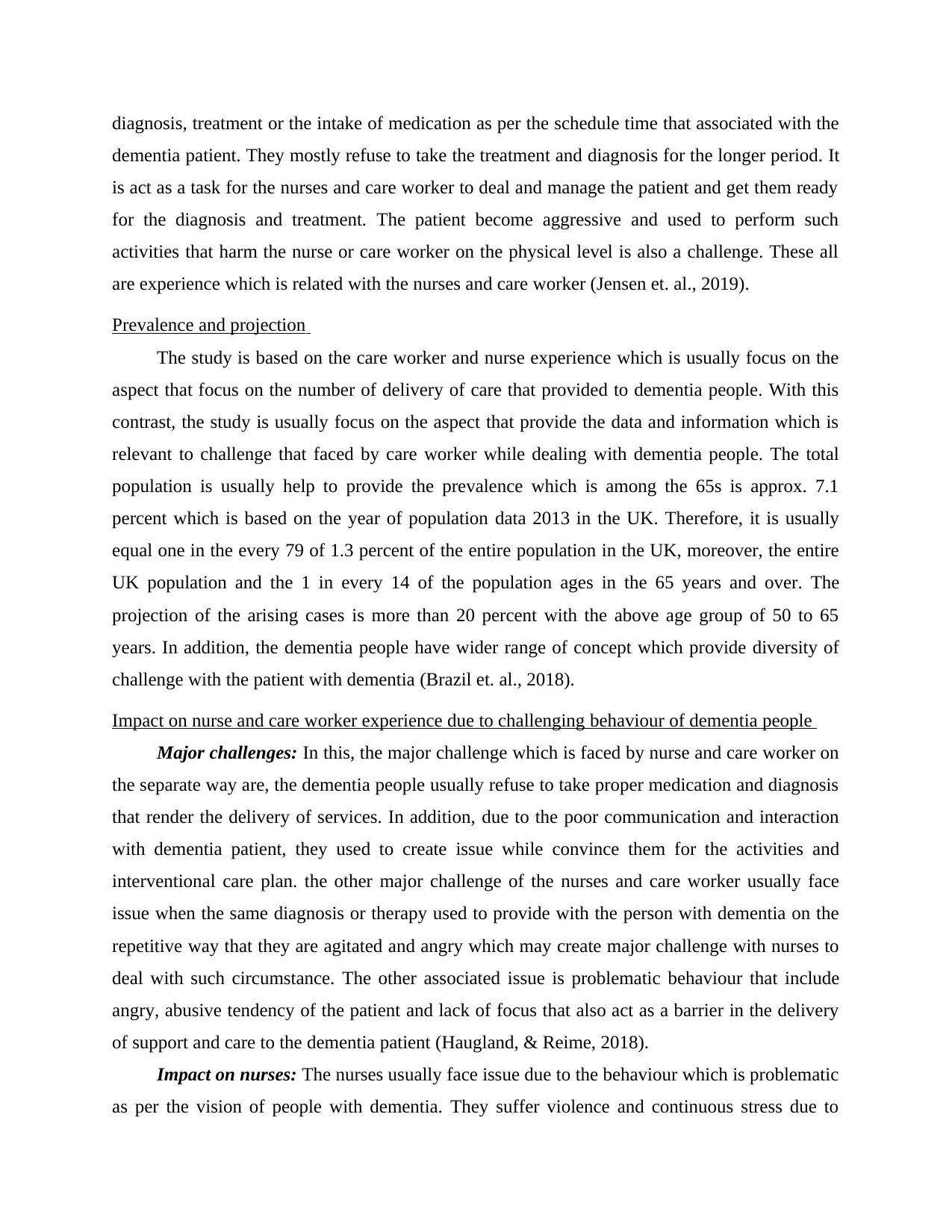
diagnosis, treatment or the intake of medication as per the schedule time that associated with the
dementia patient. They mostly refuse to take the treatment and diagnosis for the longer period. It
is act as a task for the nurses and care worker to deal and manage the patient and get them ready
for the diagnosis and treatment. The patient become aggressive and used to perform such
activities that harm the nurse or care worker on the physical level is also a challenge. These all
are experience which is related with the nurses and care worker (Jensen et. al., 2019).
Prevalence and projection
The study is based on the care worker and nurse experience which is usually focus on the
aspect that focus on the number of delivery of care that provided to dementia people. With this
contrast, the study is usually focus on the aspect that provide the data and information which is
relevant to challenge that faced by care worker while dealing with dementia people. The total
population is usually help to provide the prevalence which is among the 65s is approx. 7.1
percent which is based on the year of population data 2013 in the UK. Therefore, it is usually
equal one in the every 79 of 1.3 percent of the entire population in the UK, moreover, the entire
UK population and the 1 in every 14 of the population ages in the 65 years and over. The
projection of the arising cases is more than 20 percent with the above age group of 50 to 65
years. In addition, the dementia people have wider range of concept which provide diversity of
challenge with the patient with dementia (Brazil et. al., 2018).
Impact on nurse and care worker experience due to challenging behaviour of dementia people
Major challenges: In this, the major challenge which is faced by nurse and care worker on
the separate way are, the dementia people usually refuse to take proper medication and diagnosis
that render the delivery of services. In addition, due to the poor communication and interaction
with dementia patient, they used to create issue while convince them for the activities and
interventional care plan. the other major challenge of the nurses and care worker usually face
issue when the same diagnosis or therapy used to provide with the person with dementia on the
repetitive way that they are agitated and angry which may create major challenge with nurses to
deal with such circumstance. The other associated issue is problematic behaviour that include
angry, abusive tendency of the patient and lack of focus that also act as a barrier in the delivery
of support and care to the dementia patient (Haugland, & Reime, 2018).
Impact on nurses: The nurses usually face issue due to the behaviour which is problematic
as per the vision of people with dementia. They suffer violence and continuous stress due to
dementia patient. They mostly refuse to take the treatment and diagnosis for the longer period. It
is act as a task for the nurses and care worker to deal and manage the patient and get them ready
for the diagnosis and treatment. The patient become aggressive and used to perform such
activities that harm the nurse or care worker on the physical level is also a challenge. These all
are experience which is related with the nurses and care worker (Jensen et. al., 2019).
Prevalence and projection
The study is based on the care worker and nurse experience which is usually focus on the
aspect that focus on the number of delivery of care that provided to dementia people. With this
contrast, the study is usually focus on the aspect that provide the data and information which is
relevant to challenge that faced by care worker while dealing with dementia people. The total
population is usually help to provide the prevalence which is among the 65s is approx. 7.1
percent which is based on the year of population data 2013 in the UK. Therefore, it is usually
equal one in the every 79 of 1.3 percent of the entire population in the UK, moreover, the entire
UK population and the 1 in every 14 of the population ages in the 65 years and over. The
projection of the arising cases is more than 20 percent with the above age group of 50 to 65
years. In addition, the dementia people have wider range of concept which provide diversity of
challenge with the patient with dementia (Brazil et. al., 2018).
Impact on nurse and care worker experience due to challenging behaviour of dementia people
Major challenges: In this, the major challenge which is faced by nurse and care worker on
the separate way are, the dementia people usually refuse to take proper medication and diagnosis
that render the delivery of services. In addition, due to the poor communication and interaction
with dementia patient, they used to create issue while convince them for the activities and
interventional care plan. the other major challenge of the nurses and care worker usually face
issue when the same diagnosis or therapy used to provide with the person with dementia on the
repetitive way that they are agitated and angry which may create major challenge with nurses to
deal with such circumstance. The other associated issue is problematic behaviour that include
angry, abusive tendency of the patient and lack of focus that also act as a barrier in the delivery
of support and care to the dementia patient (Haugland, & Reime, 2018).
Impact on nurses: The nurses usually face issue due to the behaviour which is problematic
as per the vision of people with dementia. They suffer violence and continuous stress due to
⊘ This is a preview!⊘
Do you want full access?
Subscribe today to unlock all pages.

Trusted by 1+ million students worldwide
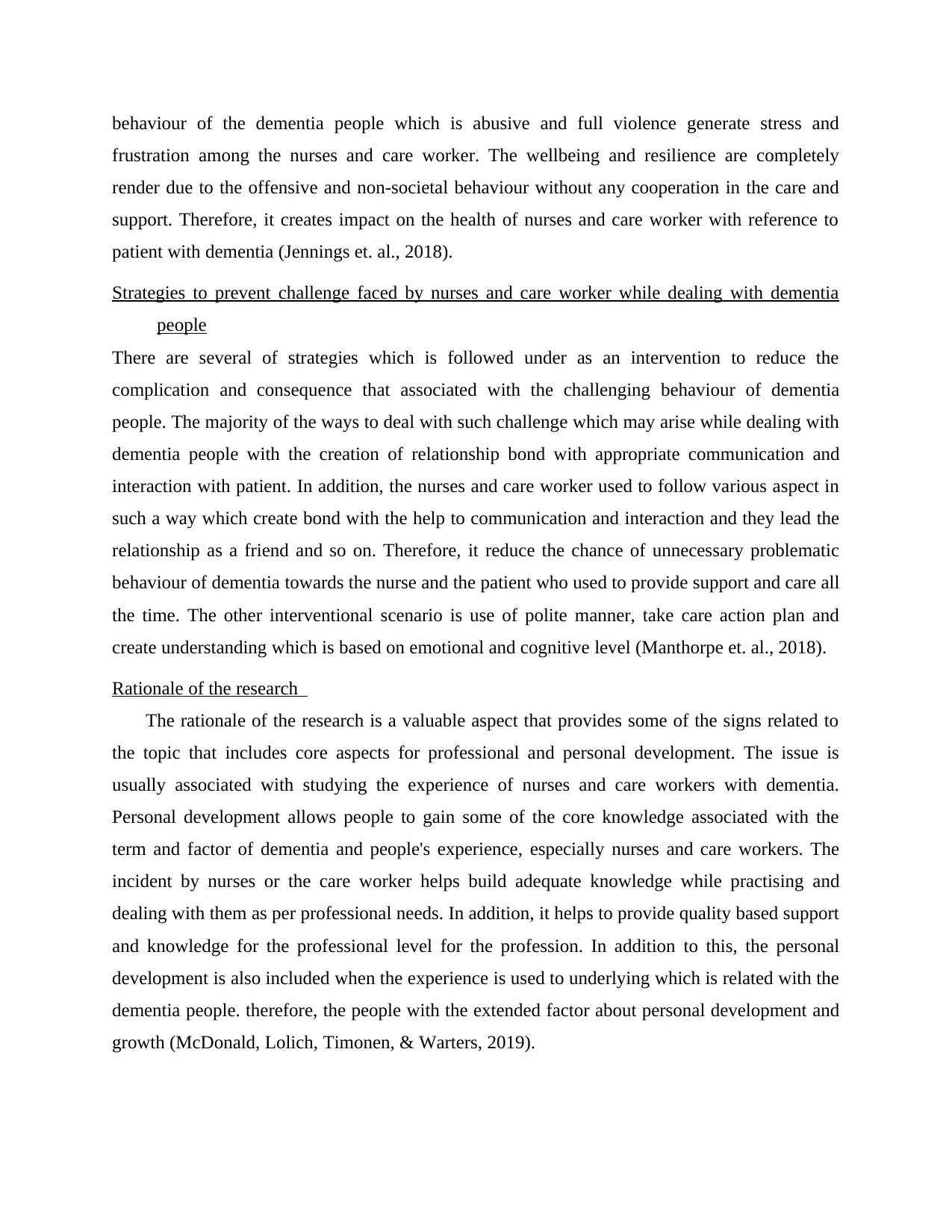
behaviour of the dementia people which is abusive and full violence generate stress and
frustration among the nurses and care worker. The wellbeing and resilience are completely
render due to the offensive and non-societal behaviour without any cooperation in the care and
support. Therefore, it creates impact on the health of nurses and care worker with reference to
patient with dementia (Jennings et. al., 2018).
Strategies to prevent challenge faced by nurses and care worker while dealing with dementia
people
There are several of strategies which is followed under as an intervention to reduce the
complication and consequence that associated with the challenging behaviour of dementia
people. The majority of the ways to deal with such challenge which may arise while dealing with
dementia people with the creation of relationship bond with appropriate communication and
interaction with patient. In addition, the nurses and care worker used to follow various aspect in
such a way which create bond with the help to communication and interaction and they lead the
relationship as a friend and so on. Therefore, it reduce the chance of unnecessary problematic
behaviour of dementia towards the nurse and the patient who used to provide support and care all
the time. The other interventional scenario is use of polite manner, take care action plan and
create understanding which is based on emotional and cognitive level (Manthorpe et. al., 2018).
Rationale of the research
The rationale of the research is a valuable aspect that provides some of the signs related to
the topic that includes core aspects for professional and personal development. The issue is
usually associated with studying the experience of nurses and care workers with dementia.
Personal development allows people to gain some of the core knowledge associated with the
term and factor of dementia and people's experience, especially nurses and care workers. The
incident by nurses or the care worker helps build adequate knowledge while practising and
dealing with them as per professional needs. In addition, it helps to provide quality based support
and knowledge for the professional level for the profession. In addition to this, the personal
development is also included when the experience is used to underlying which is related with the
dementia people. therefore, the people with the extended factor about personal development and
growth (McDonald, Lolich, Timonen, & Warters, 2019).
frustration among the nurses and care worker. The wellbeing and resilience are completely
render due to the offensive and non-societal behaviour without any cooperation in the care and
support. Therefore, it creates impact on the health of nurses and care worker with reference to
patient with dementia (Jennings et. al., 2018).
Strategies to prevent challenge faced by nurses and care worker while dealing with dementia
people
There are several of strategies which is followed under as an intervention to reduce the
complication and consequence that associated with the challenging behaviour of dementia
people. The majority of the ways to deal with such challenge which may arise while dealing with
dementia people with the creation of relationship bond with appropriate communication and
interaction with patient. In addition, the nurses and care worker used to follow various aspect in
such a way which create bond with the help to communication and interaction and they lead the
relationship as a friend and so on. Therefore, it reduce the chance of unnecessary problematic
behaviour of dementia towards the nurse and the patient who used to provide support and care all
the time. The other interventional scenario is use of polite manner, take care action plan and
create understanding which is based on emotional and cognitive level (Manthorpe et. al., 2018).
Rationale of the research
The rationale of the research is a valuable aspect that provides some of the signs related to
the topic that includes core aspects for professional and personal development. The issue is
usually associated with studying the experience of nurses and care workers with dementia.
Personal development allows people to gain some of the core knowledge associated with the
term and factor of dementia and people's experience, especially nurses and care workers. The
incident by nurses or the care worker helps build adequate knowledge while practising and
dealing with them as per professional needs. In addition, it helps to provide quality based support
and knowledge for the professional level for the profession. In addition to this, the personal
development is also included when the experience is used to underlying which is related with the
dementia people. therefore, the people with the extended factor about personal development and
growth (McDonald, Lolich, Timonen, & Warters, 2019).
Paraphrase This Document
Need a fresh take? Get an instant paraphrase of this document with our AI Paraphraser
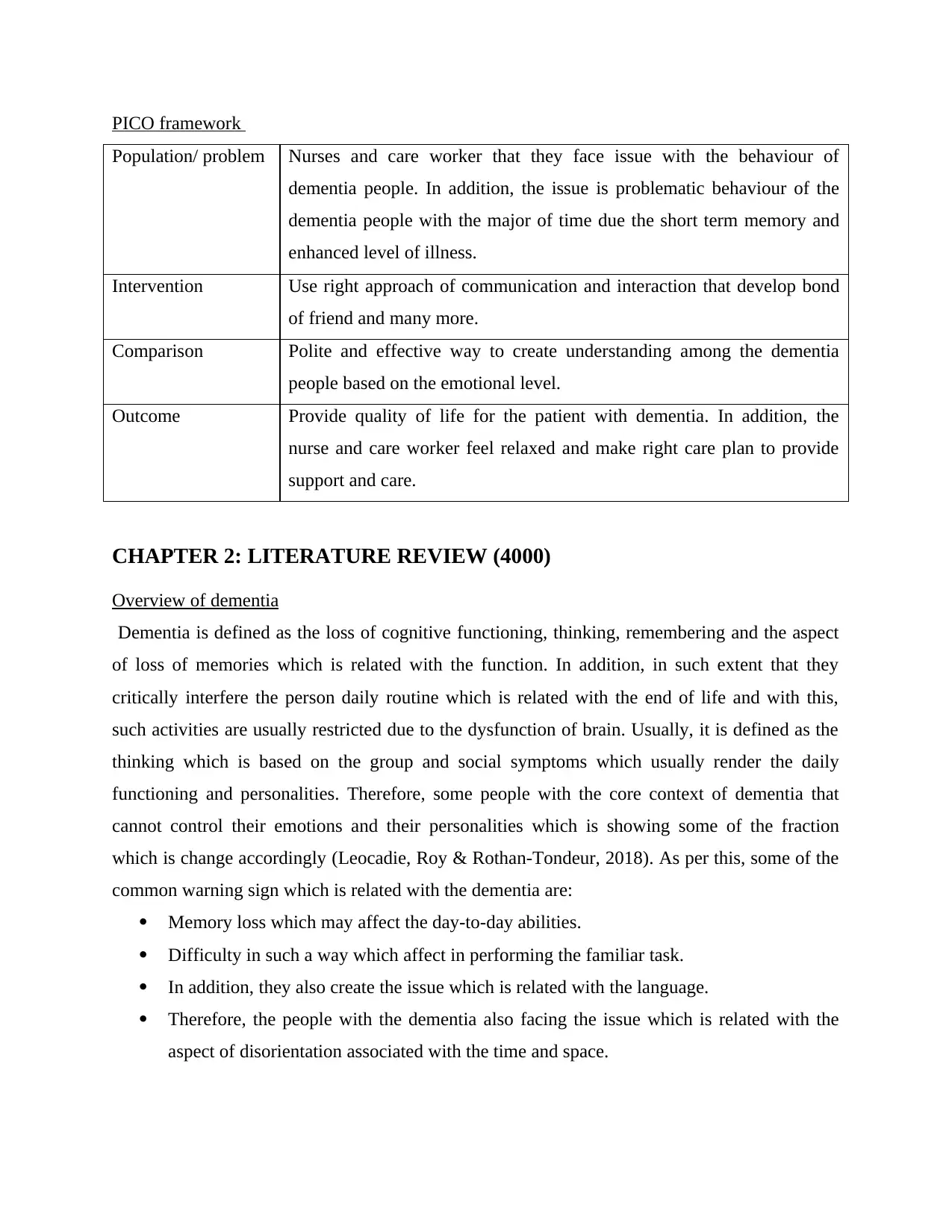
PICO framework
Population/ problem Nurses and care worker that they face issue with the behaviour of
dementia people. In addition, the issue is problematic behaviour of the
dementia people with the major of time due the short term memory and
enhanced level of illness.
Intervention Use right approach of communication and interaction that develop bond
of friend and many more.
Comparison Polite and effective way to create understanding among the dementia
people based on the emotional level.
Outcome Provide quality of life for the patient with dementia. In addition, the
nurse and care worker feel relaxed and make right care plan to provide
support and care.
CHAPTER 2: LITERATURE REVIEW (4000)
Overview of dementia
Dementia is defined as the loss of cognitive functioning, thinking, remembering and the aspect
of loss of memories which is related with the function. In addition, in such extent that they
critically interfere the person daily routine which is related with the end of life and with this,
such activities are usually restricted due to the dysfunction of brain. Usually, it is defined as the
thinking which is based on the group and social symptoms which usually render the daily
functioning and personalities. Therefore, some people with the core context of dementia that
cannot control their emotions and their personalities which is showing some of the fraction
which is change accordingly (Leocadie, Roy & Rothan-Tondeur, 2018). As per this, some of the
common warning sign which is related with the dementia are:
Memory loss which may affect the day-to-day abilities.
Difficulty in such a way which affect in performing the familiar task.
In addition, they also create the issue which is related with the language.
Therefore, the people with the dementia also facing the issue which is related with the
aspect of disorientation associated with the time and space.
Population/ problem Nurses and care worker that they face issue with the behaviour of
dementia people. In addition, the issue is problematic behaviour of the
dementia people with the major of time due the short term memory and
enhanced level of illness.
Intervention Use right approach of communication and interaction that develop bond
of friend and many more.
Comparison Polite and effective way to create understanding among the dementia
people based on the emotional level.
Outcome Provide quality of life for the patient with dementia. In addition, the
nurse and care worker feel relaxed and make right care plan to provide
support and care.
CHAPTER 2: LITERATURE REVIEW (4000)
Overview of dementia
Dementia is defined as the loss of cognitive functioning, thinking, remembering and the aspect
of loss of memories which is related with the function. In addition, in such extent that they
critically interfere the person daily routine which is related with the end of life and with this,
such activities are usually restricted due to the dysfunction of brain. Usually, it is defined as the
thinking which is based on the group and social symptoms which usually render the daily
functioning and personalities. Therefore, some people with the core context of dementia that
cannot control their emotions and their personalities which is showing some of the fraction
which is change accordingly (Leocadie, Roy & Rothan-Tondeur, 2018). As per this, some of the
common warning sign which is related with the dementia are:
Memory loss which may affect the day-to-day abilities.
Difficulty in such a way which affect in performing the familiar task.
In addition, they also create the issue which is related with the language.
Therefore, the people with the dementia also facing the issue which is related with the
aspect of disorientation associated with the time and space.
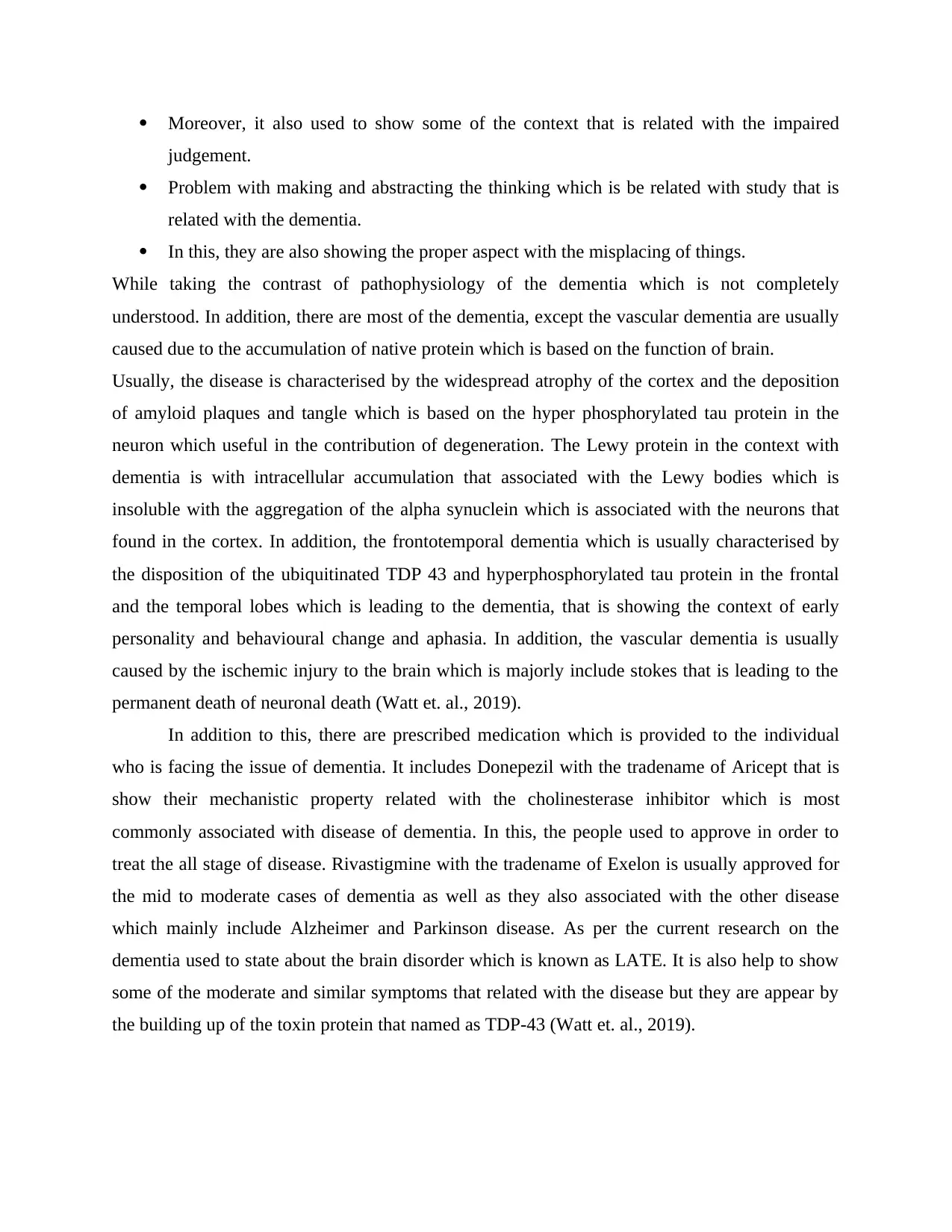
Moreover, it also used to show some of the context that is related with the impaired
judgement.
Problem with making and abstracting the thinking which is be related with study that is
related with the dementia.
In this, they are also showing the proper aspect with the misplacing of things.
While taking the contrast of pathophysiology of the dementia which is not completely
understood. In addition, there are most of the dementia, except the vascular dementia are usually
caused due to the accumulation of native protein which is based on the function of brain.
Usually, the disease is characterised by the widespread atrophy of the cortex and the deposition
of amyloid plaques and tangle which is based on the hyper phosphorylated tau protein in the
neuron which useful in the contribution of degeneration. The Lewy protein in the context with
dementia is with intracellular accumulation that associated with the Lewy bodies which is
insoluble with the aggregation of the alpha synuclein which is associated with the neurons that
found in the cortex. In addition, the frontotemporal dementia which is usually characterised by
the disposition of the ubiquitinated TDP 43 and hyperphosphorylated tau protein in the frontal
and the temporal lobes which is leading to the dementia, that is showing the context of early
personality and behavioural change and aphasia. In addition, the vascular dementia is usually
caused by the ischemic injury to the brain which is majorly include stokes that is leading to the
permanent death of neuronal death (Watt et. al., 2019).
In addition to this, there are prescribed medication which is provided to the individual
who is facing the issue of dementia. It includes Donepezil with the tradename of Aricept that is
show their mechanistic property related with the cholinesterase inhibitor which is most
commonly associated with disease of dementia. In this, the people used to approve in order to
treat the all stage of disease. Rivastigmine with the tradename of Exelon is usually approved for
the mid to moderate cases of dementia as well as they also associated with the other disease
which mainly include Alzheimer and Parkinson disease. As per the current research on the
dementia used to state about the brain disorder which is known as LATE. It is also help to show
some of the moderate and similar symptoms that related with the disease but they are appear by
the building up of the toxin protein that named as TDP-43 (Watt et. al., 2019).
judgement.
Problem with making and abstracting the thinking which is be related with study that is
related with the dementia.
In this, they are also showing the proper aspect with the misplacing of things.
While taking the contrast of pathophysiology of the dementia which is not completely
understood. In addition, there are most of the dementia, except the vascular dementia are usually
caused due to the accumulation of native protein which is based on the function of brain.
Usually, the disease is characterised by the widespread atrophy of the cortex and the deposition
of amyloid plaques and tangle which is based on the hyper phosphorylated tau protein in the
neuron which useful in the contribution of degeneration. The Lewy protein in the context with
dementia is with intracellular accumulation that associated with the Lewy bodies which is
insoluble with the aggregation of the alpha synuclein which is associated with the neurons that
found in the cortex. In addition, the frontotemporal dementia which is usually characterised by
the disposition of the ubiquitinated TDP 43 and hyperphosphorylated tau protein in the frontal
and the temporal lobes which is leading to the dementia, that is showing the context of early
personality and behavioural change and aphasia. In addition, the vascular dementia is usually
caused by the ischemic injury to the brain which is majorly include stokes that is leading to the
permanent death of neuronal death (Watt et. al., 2019).
In addition to this, there are prescribed medication which is provided to the individual
who is facing the issue of dementia. It includes Donepezil with the tradename of Aricept that is
show their mechanistic property related with the cholinesterase inhibitor which is most
commonly associated with disease of dementia. In this, the people used to approve in order to
treat the all stage of disease. Rivastigmine with the tradename of Exelon is usually approved for
the mid to moderate cases of dementia as well as they also associated with the other disease
which mainly include Alzheimer and Parkinson disease. As per the current research on the
dementia used to state about the brain disorder which is known as LATE. It is also help to show
some of the moderate and similar symptoms that related with the disease but they are appear by
the building up of the toxin protein that named as TDP-43 (Watt et. al., 2019).
⊘ This is a preview!⊘
Do you want full access?
Subscribe today to unlock all pages.

Trusted by 1+ million students worldwide
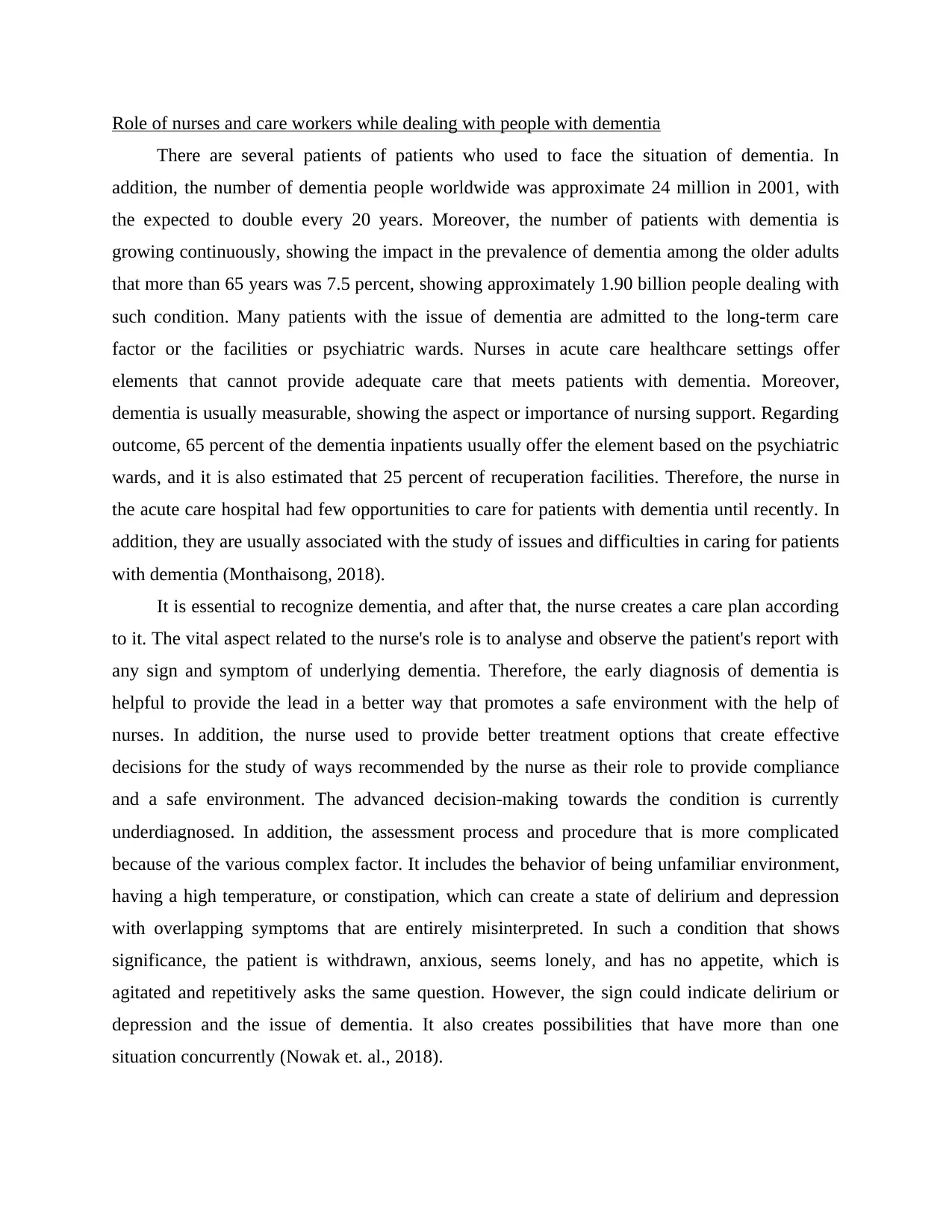
Role of nurses and care workers while dealing with people with dementia
There are several patients of patients who used to face the situation of dementia. In
addition, the number of dementia people worldwide was approximate 24 million in 2001, with
the expected to double every 20 years. Moreover, the number of patients with dementia is
growing continuously, showing the impact in the prevalence of dementia among the older adults
that more than 65 years was 7.5 percent, showing approximately 1.90 billion people dealing with
such condition. Many patients with the issue of dementia are admitted to the long-term care
factor or the facilities or psychiatric wards. Nurses in acute care healthcare settings offer
elements that cannot provide adequate care that meets patients with dementia. Moreover,
dementia is usually measurable, showing the aspect or importance of nursing support. Regarding
outcome, 65 percent of the dementia inpatients usually offer the element based on the psychiatric
wards, and it is also estimated that 25 percent of recuperation facilities. Therefore, the nurse in
the acute care hospital had few opportunities to care for patients with dementia until recently. In
addition, they are usually associated with the study of issues and difficulties in caring for patients
with dementia (Monthaisong, 2018).
It is essential to recognize dementia, and after that, the nurse creates a care plan according
to it. The vital aspect related to the nurse's role is to analyse and observe the patient's report with
any sign and symptom of underlying dementia. Therefore, the early diagnosis of dementia is
helpful to provide the lead in a better way that promotes a safe environment with the help of
nurses. In addition, the nurse used to provide better treatment options that create effective
decisions for the study of ways recommended by the nurse as their role to provide compliance
and a safe environment. The advanced decision-making towards the condition is currently
underdiagnosed. In addition, the assessment process and procedure that is more complicated
because of the various complex factor. It includes the behavior of being unfamiliar environment,
having a high temperature, or constipation, which can create a state of delirium and depression
with overlapping symptoms that are entirely misinterpreted. In such a condition that shows
significance, the patient is withdrawn, anxious, seems lonely, and has no appetite, which is
agitated and repetitively asks the same question. However, the sign could indicate delirium or
depression and the issue of dementia. It also creates possibilities that have more than one
situation concurrently (Nowak et. al., 2018).
There are several patients of patients who used to face the situation of dementia. In
addition, the number of dementia people worldwide was approximate 24 million in 2001, with
the expected to double every 20 years. Moreover, the number of patients with dementia is
growing continuously, showing the impact in the prevalence of dementia among the older adults
that more than 65 years was 7.5 percent, showing approximately 1.90 billion people dealing with
such condition. Many patients with the issue of dementia are admitted to the long-term care
factor or the facilities or psychiatric wards. Nurses in acute care healthcare settings offer
elements that cannot provide adequate care that meets patients with dementia. Moreover,
dementia is usually measurable, showing the aspect or importance of nursing support. Regarding
outcome, 65 percent of the dementia inpatients usually offer the element based on the psychiatric
wards, and it is also estimated that 25 percent of recuperation facilities. Therefore, the nurse in
the acute care hospital had few opportunities to care for patients with dementia until recently. In
addition, they are usually associated with the study of issues and difficulties in caring for patients
with dementia (Monthaisong, 2018).
It is essential to recognize dementia, and after that, the nurse creates a care plan according
to it. The vital aspect related to the nurse's role is to analyse and observe the patient's report with
any sign and symptom of underlying dementia. Therefore, the early diagnosis of dementia is
helpful to provide the lead in a better way that promotes a safe environment with the help of
nurses. In addition, the nurse used to provide better treatment options that create effective
decisions for the study of ways recommended by the nurse as their role to provide compliance
and a safe environment. The advanced decision-making towards the condition is currently
underdiagnosed. In addition, the assessment process and procedure that is more complicated
because of the various complex factor. It includes the behavior of being unfamiliar environment,
having a high temperature, or constipation, which can create a state of delirium and depression
with overlapping symptoms that are entirely misinterpreted. In such a condition that shows
significance, the patient is withdrawn, anxious, seems lonely, and has no appetite, which is
agitated and repetitively asks the same question. However, the sign could indicate delirium or
depression and the issue of dementia. It also creates possibilities that have more than one
situation concurrently (Nowak et. al., 2018).
Paraphrase This Document
Need a fresh take? Get an instant paraphrase of this document with our AI Paraphraser
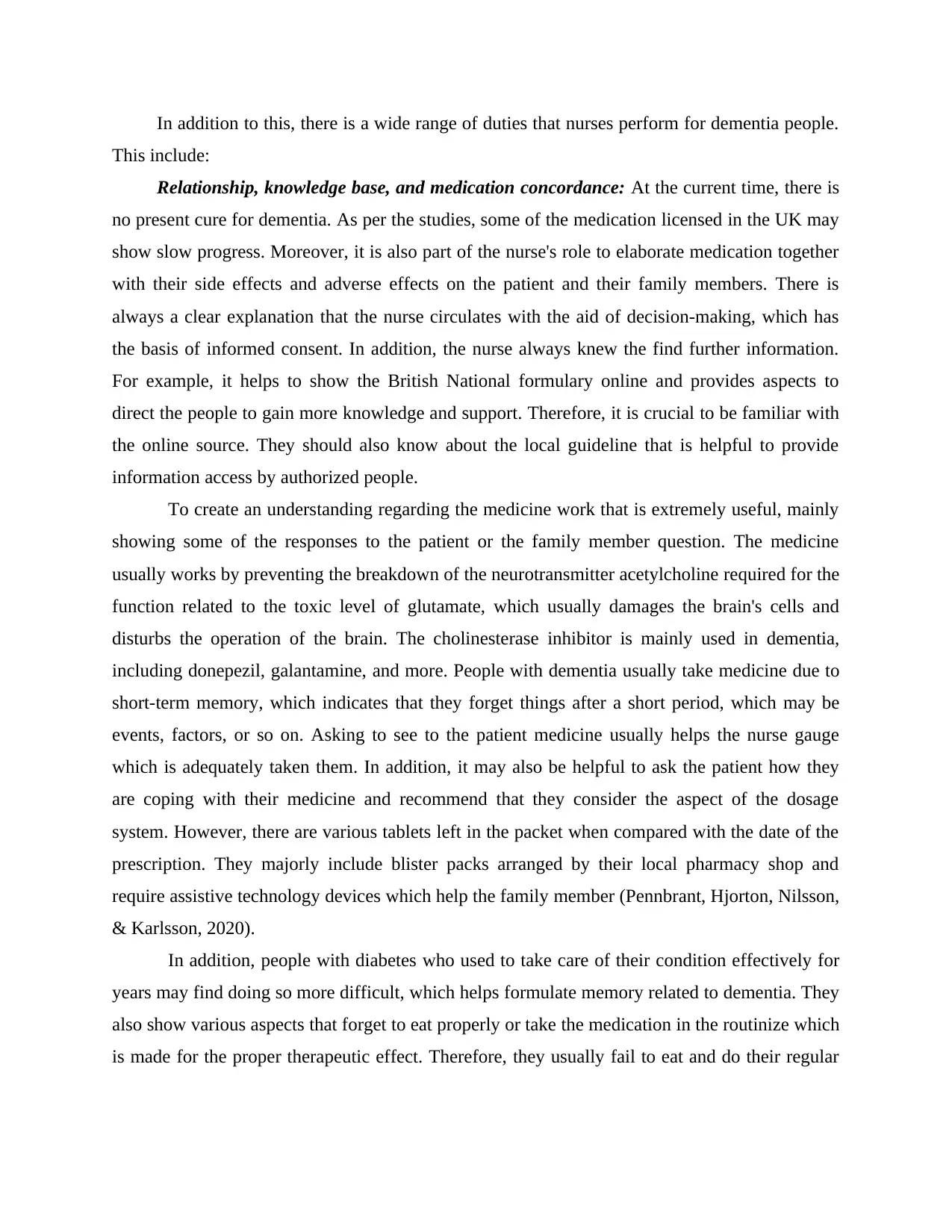
In addition to this, there is a wide range of duties that nurses perform for dementia people.
This include:
Relationship, knowledge base, and medication concordance: At the current time, there is
no present cure for dementia. As per the studies, some of the medication licensed in the UK may
show slow progress. Moreover, it is also part of the nurse's role to elaborate medication together
with their side effects and adverse effects on the patient and their family members. There is
always a clear explanation that the nurse circulates with the aid of decision-making, which has
the basis of informed consent. In addition, the nurse always knew the find further information.
For example, it helps to show the British National formulary online and provides aspects to
direct the people to gain more knowledge and support. Therefore, it is crucial to be familiar with
the online source. They should also know about the local guideline that is helpful to provide
information access by authorized people.
To create an understanding regarding the medicine work that is extremely useful, mainly
showing some of the responses to the patient or the family member question. The medicine
usually works by preventing the breakdown of the neurotransmitter acetylcholine required for the
function related to the toxic level of glutamate, which usually damages the brain's cells and
disturbs the operation of the brain. The cholinesterase inhibitor is mainly used in dementia,
including donepezil, galantamine, and more. People with dementia usually take medicine due to
short-term memory, which indicates that they forget things after a short period, which may be
events, factors, or so on. Asking to see to the patient medicine usually helps the nurse gauge
which is adequately taken them. In addition, it may also be helpful to ask the patient how they
are coping with their medicine and recommend that they consider the aspect of the dosage
system. However, there are various tablets left in the packet when compared with the date of the
prescription. They majorly include blister packs arranged by their local pharmacy shop and
require assistive technology devices which help the family member (Pennbrant, Hjorton, Nilsson,
& Karlsson, 2020).
In addition, people with diabetes who used to take care of their condition effectively for
years may find doing so more difficult, which helps formulate memory related to dementia. They
also show various aspects that forget to eat properly or take the medication in the routinize which
is made for the proper therapeutic effect. Therefore, they usually fail to eat and do their regular
This include:
Relationship, knowledge base, and medication concordance: At the current time, there is
no present cure for dementia. As per the studies, some of the medication licensed in the UK may
show slow progress. Moreover, it is also part of the nurse's role to elaborate medication together
with their side effects and adverse effects on the patient and their family members. There is
always a clear explanation that the nurse circulates with the aid of decision-making, which has
the basis of informed consent. In addition, the nurse always knew the find further information.
For example, it helps to show the British National formulary online and provides aspects to
direct the people to gain more knowledge and support. Therefore, it is crucial to be familiar with
the online source. They should also know about the local guideline that is helpful to provide
information access by authorized people.
To create an understanding regarding the medicine work that is extremely useful, mainly
showing some of the responses to the patient or the family member question. The medicine
usually works by preventing the breakdown of the neurotransmitter acetylcholine required for the
function related to the toxic level of glutamate, which usually damages the brain's cells and
disturbs the operation of the brain. The cholinesterase inhibitor is mainly used in dementia,
including donepezil, galantamine, and more. People with dementia usually take medicine due to
short-term memory, which indicates that they forget things after a short period, which may be
events, factors, or so on. Asking to see to the patient medicine usually helps the nurse gauge
which is adequately taken them. In addition, it may also be helpful to ask the patient how they
are coping with their medicine and recommend that they consider the aspect of the dosage
system. However, there are various tablets left in the packet when compared with the date of the
prescription. They majorly include blister packs arranged by their local pharmacy shop and
require assistive technology devices which help the family member (Pennbrant, Hjorton, Nilsson,
& Karlsson, 2020).
In addition, people with diabetes who used to take care of their condition effectively for
years may find doing so more difficult, which helps formulate memory related to dementia. They
also show various aspects that forget to eat properly or take the medication in the routinize which
is made for the proper therapeutic effect. Therefore, they usually fail to eat and do their regular
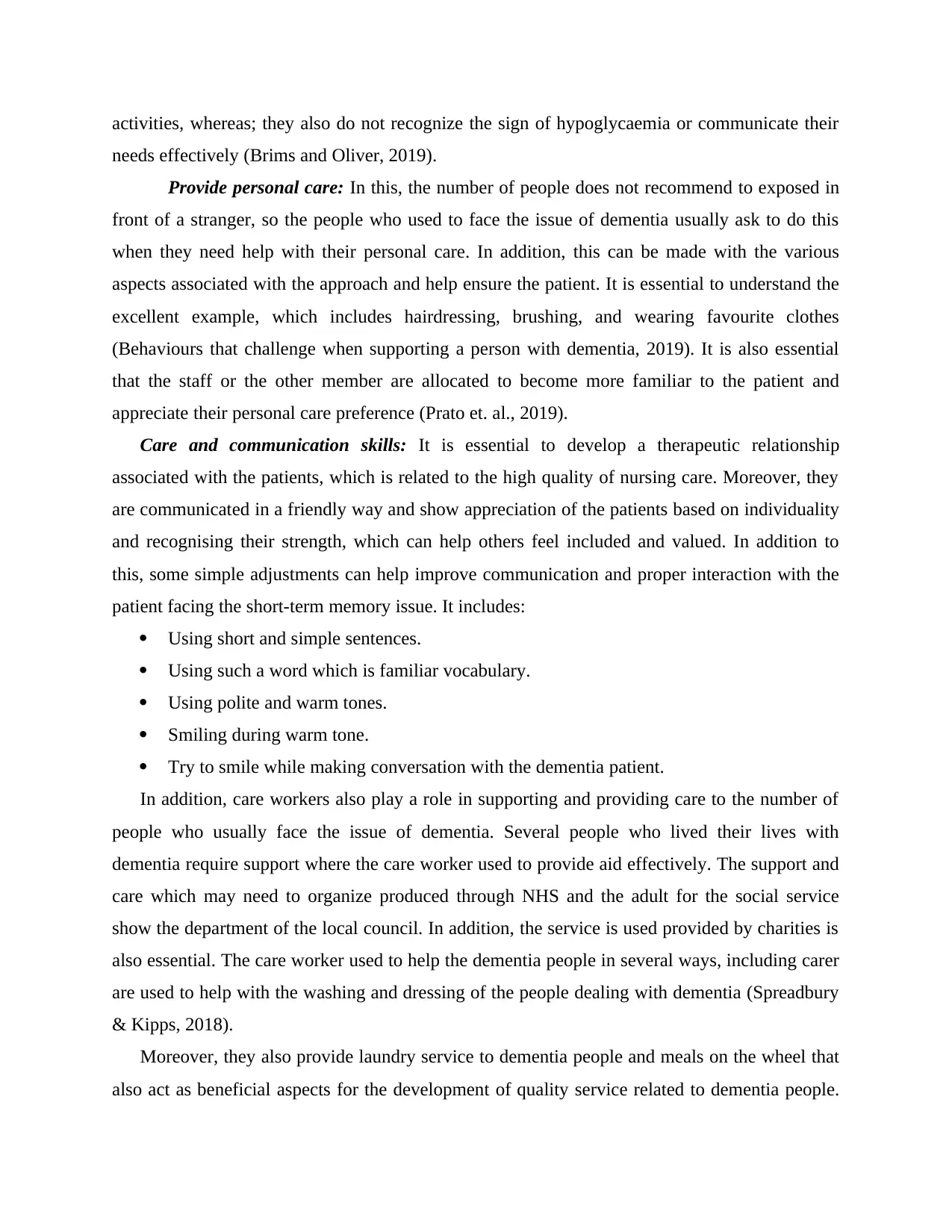
activities, whereas; they also do not recognize the sign of hypoglycaemia or communicate their
needs effectively (Brims and Oliver, 2019).
Provide personal care: In this, the number of people does not recommend to exposed in
front of a stranger, so the people who used to face the issue of dementia usually ask to do this
when they need help with their personal care. In addition, this can be made with the various
aspects associated with the approach and help ensure the patient. It is essential to understand the
excellent example, which includes hairdressing, brushing, and wearing favourite clothes
(Behaviours that challenge when supporting a person with dementia, 2019). It is also essential
that the staff or the other member are allocated to become more familiar to the patient and
appreciate their personal care preference (Prato et. al., 2019).
Care and communication skills: It is essential to develop a therapeutic relationship
associated with the patients, which is related to the high quality of nursing care. Moreover, they
are communicated in a friendly way and show appreciation of the patients based on individuality
and recognising their strength, which can help others feel included and valued. In addition to
this, some simple adjustments can help improve communication and proper interaction with the
patient facing the short-term memory issue. It includes:
Using short and simple sentences.
Using such a word which is familiar vocabulary.
Using polite and warm tones.
Smiling during warm tone.
Try to smile while making conversation with the dementia patient.
In addition, care workers also play a role in supporting and providing care to the number of
people who usually face the issue of dementia. Several people who lived their lives with
dementia require support where the care worker used to provide aid effectively. The support and
care which may need to organize produced through NHS and the adult for the social service
show the department of the local council. In addition, the service is used provided by charities is
also essential. The care worker used to help the dementia people in several ways, including carer
are used to help with the washing and dressing of the people dealing with dementia (Spreadbury
& Kipps, 2018).
Moreover, they also provide laundry service to dementia people and meals on the wheel that
also act as beneficial aspects for the development of quality service related to dementia people.
needs effectively (Brims and Oliver, 2019).
Provide personal care: In this, the number of people does not recommend to exposed in
front of a stranger, so the people who used to face the issue of dementia usually ask to do this
when they need help with their personal care. In addition, this can be made with the various
aspects associated with the approach and help ensure the patient. It is essential to understand the
excellent example, which includes hairdressing, brushing, and wearing favourite clothes
(Behaviours that challenge when supporting a person with dementia, 2019). It is also essential
that the staff or the other member are allocated to become more familiar to the patient and
appreciate their personal care preference (Prato et. al., 2019).
Care and communication skills: It is essential to develop a therapeutic relationship
associated with the patients, which is related to the high quality of nursing care. Moreover, they
are communicated in a friendly way and show appreciation of the patients based on individuality
and recognising their strength, which can help others feel included and valued. In addition to
this, some simple adjustments can help improve communication and proper interaction with the
patient facing the short-term memory issue. It includes:
Using short and simple sentences.
Using such a word which is familiar vocabulary.
Using polite and warm tones.
Smiling during warm tone.
Try to smile while making conversation with the dementia patient.
In addition, care workers also play a role in supporting and providing care to the number of
people who usually face the issue of dementia. Several people who lived their lives with
dementia require support where the care worker used to provide aid effectively. The support and
care which may need to organize produced through NHS and the adult for the social service
show the department of the local council. In addition, the service is used provided by charities is
also essential. The care worker used to help the dementia people in several ways, including carer
are used to help with the washing and dressing of the people dealing with dementia (Spreadbury
& Kipps, 2018).
Moreover, they also provide laundry service to dementia people and meals on the wheel that
also act as beneficial aspects for the development of quality service related to dementia people.
⊘ This is a preview!⊘
Do you want full access?
Subscribe today to unlock all pages.

Trusted by 1+ million students worldwide
1 out of 53
Related Documents
Your All-in-One AI-Powered Toolkit for Academic Success.
+13062052269
info@desklib.com
Available 24*7 on WhatsApp / Email
![[object Object]](/_next/static/media/star-bottom.7253800d.svg)
Unlock your academic potential
Copyright © 2020–2025 A2Z Services. All Rights Reserved. Developed and managed by ZUCOL.





